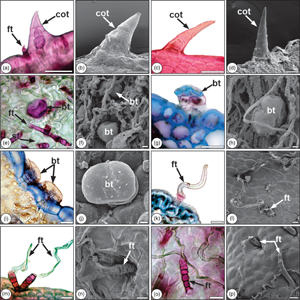Crossref Citations
This article has been cited by the following publications. This list is generated based on data provided by
Crossref.
Manfron, Jane
Farago, Paulo Vitor
Khan, Ikhlas Ahmed
and
Raman, Vijayasankar
2021.
Baccharis.
p.
217.
Gribner, Caroline
Barbosa, Vanessa
Monteiro, Luciane Mendes
Swiech, Juliane Nadal Dias
Raman, Vijayasankar
Manfron, Jane
Miguel, Obdulio Gomes
Montrucchio, Deise Prehs
and
de Fátima Gaspari Dias, Josiane
2022.
Microscopic investigations of Ocotea paranaensis―A Brazilian endemic and endangered species.
Microscopy Research and Technique,
Vol. 85,
Issue. 10,
p.
3316.
Nazari Formagio, Anelise Samara
Vilegas, Wagner
Ferreira Volobuff, Carla Roberta
Leite Kassuya, Candida Aparecida
Paes de Almeida, Valter
Manfron, Jane
Pereira, Zefa Valdevina
Pereira Cabral, Marcia Regina
and
Sarragiotto, Maria Helena
2022.
Palicourea tomentosa (Aubl.) Borhidi: Microscopy, chemical composition and the analgesic, anti-inflammatory and anti-acetylcholinesterase potential.
Journal of Ethnopharmacology,
Vol. 291,
Issue. ,
p.
115050.
Barbosa, Vanessa
Almeida, Valter Paes de
Manfron, Jane
Raman, Vijayasankar
Oliveira, Camila Freitas de
Betim, Fernando Cesar Martins
Cruz, Luiza Stolz
Swiech, Juliane Nadal Dias
Oliveira, Vinicius Berdnarczuk de
Paula, Josiane de Fátima Padilha de
and
Miguel, Obdúlio Gomes
2023.
Antioxidant Activity and Determination of Phenolic Compounds, Total Flavonoids and Hispidulin in Baccharis erioclada DC..
Brazilian Archives of Biology and Technology,
Vol. 66,
Issue. ,
de Almeida, Valter Paes
Monchak, Irailson Thierry
da Costa Batista, João Vitor
Grazi, Mirio
Ramm, Hartmut
Raman, Vijayasankar
Baumgartner, Stephan
Holandino, Carla
and
Manfron, Jane
2023.
Investigations on the morpho-anatomy and histochemistry of the European mistletoe: Viscum album L. subsp. album.
Scientific Reports,
Vol. 13,
Issue. 1,
Raeski, Paola Aparecida
Heiden, Gustavo
Novatski, Andressa
Raman, Vijayasankar
Khan, Ikhlas Ahmed
and
Manfron, Jane
2023.
Calcium oxalate crystal macropattern and its usefulness in the taxonomy of Baccharis (Asteraceae).
Microscopy Research and Technique,
Vol. 86,
Issue. 7,
p.
862.
Konarska, Agata
Weryszko-Chmielewska, Elżbieta
Sulborska-Różycka, Aneta
Kiełtyka-Dadasiewicz, Anna
Dmitruk, Marta
and
Gorzel, Małgorzata
2023.
Herb and Flowers of Achillea millefolium subsp. millefolium L.: Structure and Histochemistry of Secretory Tissues and Phytochemistry of Essential Oils.
Molecules,
Vol. 28,
Issue. 23,
p.
7791.
Antunes, Kevin A
Monteiro, Luciane M
Almeida, Valter P
Monchak, Irailson T
Perera, Wilmer H
Heiden, Gustavo
Guarino, Ernestino S G
Santos, Vera L P
Farago, Paulo V
Raman, Vijayasankar
Khan, Ikhlas A
and
Manfron, Jane
2023.
Authentication and Quality Control of the Brazilian Traditional Herb “Espinheira-Santa” (Monteverdia ilicifolia) by Morpho-Anatomy and Microscopy.
Microscopy and Microanalysis,
Vol. 29,
Issue. 5,
p.
1809.
Paes de Almeida, Valter
Tolouei, Sara Emília Lima
Minteguiaga, Manuel
Chaves, Douglas Siqueira de Almeida
Heiden, Gustavo
Khan, Shabana Iqrar
Trott, John
Wang, Mei
Dellacassa, Eduardo
Raman, Vijayasankar
Farago, Paulo Vitor
Khan, Ikhlas Ahmed
Gasparotto Junior, Arquimedes
and
Manfron, Jane
2023.
Chemical Profiles and Cytotoxic Activities of Essential Oils from Six Species ofBaccharisSubgenusCoridifoliae(Asteraceae).
Chemistry & Biodiversity,
Vol. 20,
Issue. 10,
Marangoni, Janaine Alberto
da Costa Pinto, Jannaina Velasques
Kassuya, Candida Aparecida Leite
de Oliveira Junior, Pedro Cruz
dos Santos, Sidney Mariano
Cardoso, Claudia Andrea Lima
Silva, Rosilda Mara Mussury Franco
Espíndola da Silva, Marcia
Machado, Camila Dias
Manfron, Jane
and
Formagio, Anelise Samara Nazari
2023.
Geographical variation in the chemical composition, anti-inflammatory activity of the essential oil, micromorphology and histochemistry of Schinus terebinthifolia Raddi.
Journal of Ethnopharmacology,
Vol. 301,
Issue. ,
p.
115786.
Mercado, María Inés
Albornoz, Patricia Liliana
Ruiz, Ana Inés
Guantay, María Eugenia
Rodríguez-Rego, Cecilia
Catalán, César Atilio Nazareno
González, Héctor Andrés
Dellacassa, Eduardo
and
Minteguiaga, Manuel
2024.
Morphoanatomy and histochemistry of Baccharis palustris: insights into a highly endangered endemic species from Southeastern America.
Rodriguésia,
Vol. 75,
Issue. ,
Formagio, Anelise Samara Nazari
Vilegas, Wagner
Kassuya, Cândida Aparecida Leite
De Almeida, Valter Paes
Manfron, Jane
Konkiewitz, Elisabete Castelon
Ziff, Edward Benjamin
Faoro, Janaine Alberto Marangoni
Dos Santos, Jessica Maurino
Cecatto, Ana Julia
Sarragiotto, Maria Helena
and
Mussury, Rosilda Mara
2024.
A Comprehensive Description of the Anatomy and Histochemistry of Psychotria capillacea (Müll. Arg.) Standl. and an Investigation into Its Anti-Inflammatory Effects in Mice and Role in Scopolamine-Induced Memory Impairment.
Pharmaceuticals,
Vol. 17,
Issue. 5,
p.
564.
Armstrong, Lorene
Raeski, Paola Aparecida
de Almeida, Valter Paes
Minteguiaga, Manuel
Novatski, Andressa
Raman, Vijayasankar
Gasparotto Junior, Arquimedes
Naman, C. Benjamin
and
Manfron, Jane
2024.
Baccharis dracunculifolia DC. A Review of Research Advances From 2004 to 2024, With New Micromorphology and Essential Oil Investigations.
Journal of Herbal Medicine,
Vol. 48,
Issue. ,
p.
100952.




